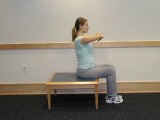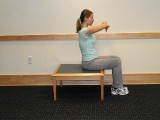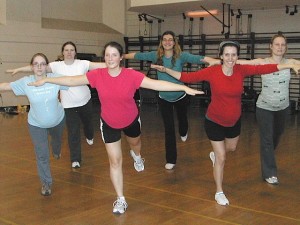These essential exercises can help to relieve discomforts during pregnancy, prepare for labor, and recover quickly. Remember:
- Protect Yourself
- Do Not Overreach Your Abilities
- You are Responsible for your Body
C‑Curve™ or “Hug the Baby”
Directions:
- Sit upright on your sitsbones (rocker-like bones on both sides of your vagina)
- Center your weight, not too far forward or back, nor more to one side than the other. Relax abdomen and inhale (left)
- Exhale, compressing the abdomen and pulling belly button toward the back (center)
- Roll back slightly, continuing to compress the abdomen (right)
- Return to upright. Inhale and relax abdomen. (left)
- Start with 3 sets of 3 at a time and progress to 3 sets of 10
Back Care Video
Check out the Yale Back Care Video.
Kegel Exercises for the Pelvic Floor
Kegel #1:
- Squeeze the sitsbones together; then inhale
- Exhale and release the sitsbones
Kegel #2:
- Squeeze the sphincter muscle around the anus, then the one around the vagina and urethra; then inhale
- Exhale and release the sphincter muscles
Kegel #3:
- Lift the pelvic floor up inside; then inhale
- Exhale and slowly lower the pelvic floor
Start with 3 of each and progress to 10 of each
For additional information, visit this DTP Blog post.
Side-Lying Rest Position

To maximize blood flow to the uterus and placenta, and to rest your postural muscles, try lying on your side (left side is most often recommended) 20 minutes a day. Listen to quiet music, use the time for contemplation, or take a nap!
Aerobic Exercises
We know that appropriate aerobic activity during pregnancy helps relieve discomforts, reduces perceived exertion, and provides stamina for labor. It is the most effective exercise component for enhancing pregnancy, birth and recovery. Here are some cautions:
- Get approval from your health care provider
- Do activities with which you are familiar
- Don’t begin a vigorous regimen after 26 weeks
- Stop if you feel fatigued
- Do not exercise if you have a fever, vaginal bleeding or excessive discharge, or if you are having regular contractions; instead, contact your health care provider.
If you are not accustomed to aerobic activities, begin with simple locomotor activities such as walking. Start with 5 or 10 minute walks 3 times a week and progress to 20 or 30 minute walks 3 — 5 times a week.
A special prenatal fitness class a couple days a week can be an important part of your fitness routine. In addition to contributing to your physical fitness, being with a group provides emotional support.
Learning to center your weight and move in a balanced way helps protect your joints and prevent injury. Always move with your weight centered and be sure to breath as you move. A qualified pre/postnatal fitness instructor can help you learn to stay active and be safe.
Tips for Abdominals — Splinting
Use curl downs to strengthen abdominals. If you are experiencing bulging along your linea alba, be sure to “splint” or pull the sides of the abdomen together while curling down as shown in photos below.


Standing Pelvic Tilt
Directions:
- Stand with your weight centered, feet about a foot apart, knees relaxed
- Flex or bend in your hip sockets, so your bottom tilts back, then inhale
- Exhale and squeeze the gluteal muscles
- Press the bottom of the pelvis forward and tilt the top back
- Release and return to starting position (center photo)
- Start with 3 sets of 5 and progress to 3 sets of 10
- This action warms muscles and fascia that control the pelvis, improving internal relaxation necessary for baby to move down.
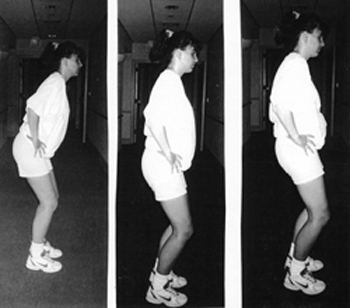
Birth Squats
Directions:
- Begin seated; bring one foot onto the floor and lean onto hands (left)
- Place other foot on the floor and adjust the position for comfort (right)
- Return to sitting by reversing the process
- Repeat 2 or 3 times, staying in the position longer as you progress
- This exercise is not advisable if you have problems with your knees

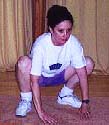
Upper Back Strengthening
Directions:
- Sit Upright and centered
- Arms forward, inhale (left)
- Exhale and slowly open arms to side (right)
- You can use an exercise tube or band as shown, or use a towel, in which case arms remain in front and the exercise is isometric. Continue breathing in and out while attempting to pull arms open.
- Start with 3 sets of 5 and progress to 3 sets of 10
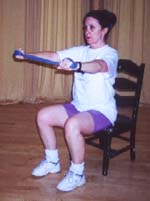
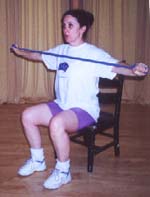
Have a question? Contact director@dancingthrupregnancy.com.

